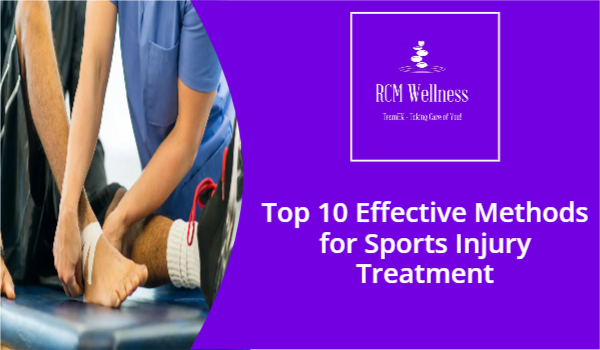Sports injuries are common among athletes and fitness enthusiasts alike. Whether you’re a professional athlete or just someone who enjoys a weekend game of football, injuries are an inevitable part of the game. Sports injuries can range from minor strains and sprains to more serious issues like fractures and ligament tears. Recovering from a sports injury requires proper care, attention, and often a combination of treatments to ensure a full and healthy recovery.
In this article, we will explore the top 10 most effective methods for sports injury treatment. We’ll look at modern techniques, as well as some traditional approaches that continue to be highly beneficial. Whether you’ve suffered a minor injury or something more severe, these methods can help get you back to doing what you love. Let’s dive into the best approaches to sports injury treatment and how they can help speed up recovery.
Rest and Immobilisation
One of the first and most important steps in sports injury treatment is rest. Giving your body time to heal is crucial. Many injuries, especially those involving muscles and ligaments, require time to recover. Continuing to put stress on an injured area can exacerbate the problem and potentially lead to long-term damage. Immobilisation is often necessary for certain injuries, such as fractures or severe sprains. This may involve using a brace, sling, or cast to prevent movement, allowing the injury to heal more effectively.
Rest and immobilisation are the foundation of recovery, as they help prevent further damage while giving your body the necessary time to heal. For athletes, this can be frustrating, but it’s an essential part of sports injury treatment. Following the advice of a medical professional and giving your body enough time to recover can ensure a quicker return to activity.
Physical Therapy and Rehabilitation
After the initial healing phase, physical therapy becomes a vital part of sports injury treatment. Physical therapists are trained to work with injured athletes to restore strength, flexibility, and mobility. A targeted rehabilitation programme is often developed based on the type and severity of the injury, focusing on exercises that can help you regain full function in the injured area.
Physical therapy often includes a combination of stretching, strength training, and aerobic exercises. The goal is to improve blood circulation to the injured area, promote healing, and prevent future injuries. For more severe injuries, physical therapy may also involve the use of specialised equipment such as resistance bands or balance boards to help restore coordination and strength.
Regular physical therapy sessions are key to a successful sports injury treatment programme. Over time, these sessions can greatly reduce pain, improve mobility, and get athletes back to their pre-injury performance levels.
Cryotherapy and Heat Therapy
Cold and heat therapies are both commonly used in sports injury treatment. Each has its own set of benefits, depending on the type and stage of the injury. Cryotherapy, or cold therapy, is typically used in the acute phase of an injury to reduce inflammation and numb pain. Applying ice packs or using specialised cold therapy machines can help limit swelling and prevent further tissue damage in the initial days following an injury.
On the other hand, heat therapy is usually applied after the acute phase to encourage blood flow to the injured area. Increased circulation helps relax muscles, alleviate stiffness, and promote healing. Heating pads, warm baths, and heat wraps are commonly used as part of heat therapy.
Both cryotherapy and heat therapy can be highly effective in sports injury treatment when used at the appropriate times. Always consult with a healthcare professional to determine which method is most suitable for your injury.
Pain Management and Medication
Managing pain is an important part of sports injury treatment, particularly in the early stages. Over-the-counter pain medications like ibuprofen or paracetamol are often recommended to help reduce pain and inflammation. For more serious injuries, prescription medications may be necessary to control severe pain or inflammation.
While medications can be effective in controlling pain, they should be used carefully and according to a doctor’s guidance. Long-term use of painkillers, particularly stronger medications, can lead to dependency or mask underlying issues that need to be addressed through other treatments.
In addition to medication, some athletes may opt for alternative pain management techniques such as acupuncture, massage therapy, or chiropractic care. These methods can provide relief and promote healing without the side effects associated with pharmaceutical painkillers.
Compression and Elevation
Compression and elevation are often used in conjunction with rest and immobilisation in the early stages of sports injury treatment. Compression involves applying pressure to the injured area using elastic bandages or specialised wraps. This helps reduce swelling and supports the injured area, which can prevent further damage.
Elevation is another key component of reducing swelling, particularly for injuries involving the lower extremities. Keeping the injured area elevated above heart level allows gravity to help drain excess fluid and reduce inflammation. This method is particularly effective in the first 24 to 48 hours following an injury and can significantly speed up recovery time.
Both compression and elevation are simple yet effective techniques in the sports injury treatment process, and they are often recommended by doctors and physical therapists alike.
Stretching and Strengthening Exercises
Once the initial healing phase is over and the pain has subsided, stretching and strengthening exercises become a crucial part of sports injury treatment. These exercises are designed to restore flexibility and strength in the injured area, which is essential for preventing future injuries and ensuring a full recovery.
Stretching helps to improve the range of motion in muscles and joints, while strengthening exercises target the specific muscles that may have weakened due to inactivity during the recovery period. It’s important to start slow and gradually increase the intensity of these exercises under the guidance of a physical therapist or coach.
Incorporating stretching and strengthening exercises into your daily routine is one of the best ways to prevent re-injury and ensure long-term success after sports injury treatment.
Massage Therapy
Massage therapy is widely recognised as a valuable component of sports injury treatment. It can help alleviate muscle tension, improve blood circulation, and promote faster recovery by stimulating the injured tissues. Massage can also reduce scar tissue formation, which can limit mobility and lead to future injuries.
Sports massage therapists are specially trained to work with athletes and understand the demands placed on the body. They use targeted techniques to address specific injuries and help speed up the recovery process. In addition to its physical benefits, massage therapy can also have mental health benefits, reducing stress and promoting relaxation during the recovery process.
Including massage therapy as part of your sports injury treatment plan can greatly improve both the speed and quality of your recovery.
Proper Nutrition and Hydration
Nutrition plays a significant role in sports injury treatment and recovery. Proper nourishment provides your body with the necessary vitamins and minerals to repair damaged tissues and support overall healing. Protein, for example, is essential for muscle repair, while vitamins like Vitamin C and D are critical for tissue regeneration and bone health.
Staying hydrated is equally important, as dehydration can slow down the healing process and lead to further complications. Drinking enough water and consuming electrolyte-rich fluids can help ensure your body has the resources it needs to recover efficiently.
Consulting with a nutritionist or dietitian who specialises in sports nutrition can be highly beneficial during the recovery process. They can recommend dietary adjustments that support your specific needs and enhance your sports injury treatment programme.
Surgery for Severe Injuries
In some cases, surgery may be required as part of sports injury treatment. This is usually reserved for more severe injuries, such as torn ligaments, fractures, or dislocations that cannot heal properly without surgical intervention. Common procedures include ligament reconstruction, arthroscopic surgery, and fracture repair.
While surgery can be an effective solution for serious injuries, it is often followed by an extended period of rehabilitation and physical therapy. It’s important to have realistic expectations about recovery time and to work closely with your healthcare provider to ensure a successful outcome.
For athletes dealing with severe injuries, surgery can provide a path to long-term recovery and a return to full activity, but it should always be considered as a last resort after exploring non-invasive sports injury treatment options.
Mental Health and Psychological Support
Dealing with a sports injury can be mentally challenging, especially for athletes who are passionate about their sport. The frustration of being sidelined, the fear of re-injury, and the uncertainty of the recovery process can all take a toll on mental health.
Psychological support is an often-overlooked aspect of sports injury treatment but can be just as important as physical recovery. Working with a sports psychologist or therapist can help athletes manage anxiety, maintain motivation, and cope with the emotional challenges that come with injury.
By addressing both the mental and physical aspects of recovery, athletes can ensure a more holistic and successful approach to sports injury treatment.
Conclusion
Sports injuries are an unfortunate reality for many athletes, but with the right treatment methods, a full recovery is often possible. From rest and physical therapy to proper nutrition and mental health support, each aspect of sports injury treatment plays a critical role in the recovery process. By combining these methods and following a tailored recovery plan, athletes can return to their sport stronger and more resilient than before.
If you’ve experienced a sports injury, we encourage you to try these effective treatment methods and share your experiences. Let us know in the comments below how you’ve managed your recovery and which methods have worked best for you. Your insights could help others on their journey to healing!





